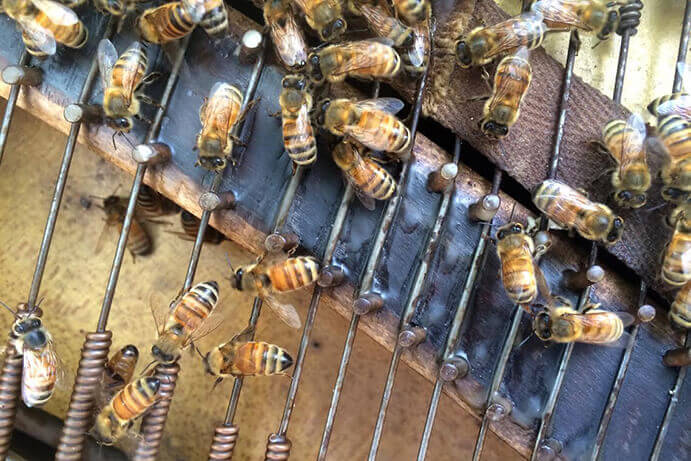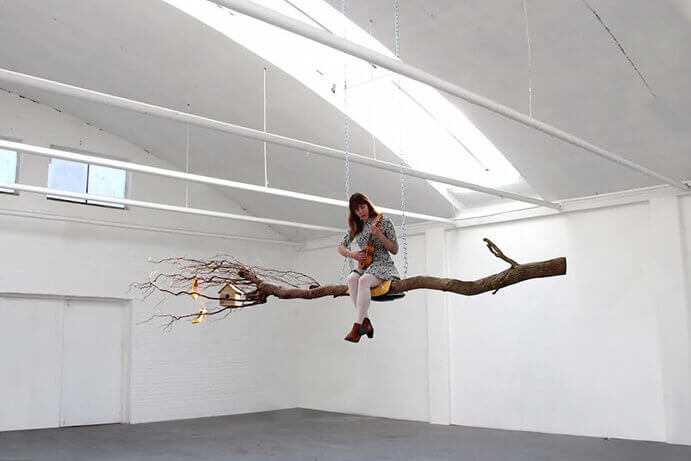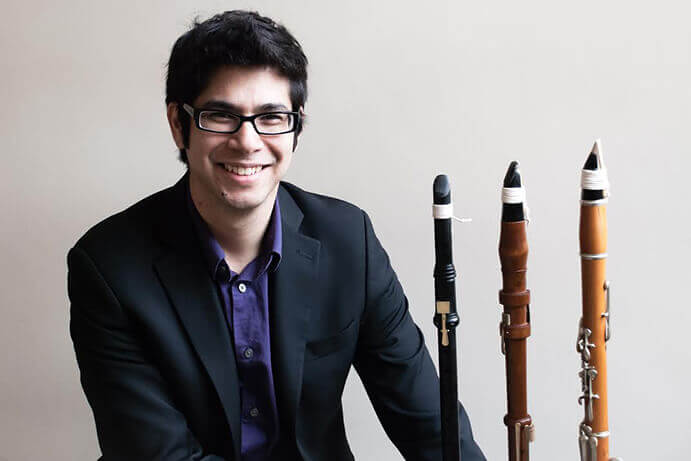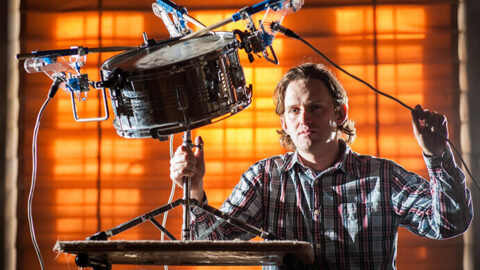Monthly Music Hackathon is back with their annual New Music Instruments Hackathon. On June 11, at Spotify’s NYC offices, the event will start at noon with talks by DJs, roboticists, sound artists, composers, and clarinet makers about their work.
Then, the hacking begins – build anything you want related to music, new instruments, and more. Original art, research, apps, and any other type of project are all fair game. Programming and technical skills are not required. Concerts & Demonstrations of hacks will start at 8:00 pm. There will also be workshops on hardware hacking, gestural music, and interactive dance.
Some of the speakers and workshop organizers took the time to answer a few questions about their work, about new instruments, and how their work informs their music. Jessica Segall will be talking about bees, music, and piano soundboards. Steve Kemper and Scott Barton will be speaking about their musical robots. Thomas Carroll will chat about making clarinets, historical and otherwise. Matt Ostrowski will discuss his current work with old rotary telephones.
People talk about “musicianship” a lot, with regards to novel instruments and interfaces. How do you feel about this word? Does it inform your instrument-making at all?
Steve Kemper: When people talk about “musicianship” in terms of novel instruments and interfaces, there always seems to be some implicit (or explicit) comparison to traditional acoustic instruments. Instrument designers often get criticized because a performer can’t learn and master new instruments in the same way as a traditional instrument. Related to the question of musicianship are ideas of virtuosity and expression–that in order for a new instrument to be successful, there needs to be a path to Paganini-esque mastery of that instrument. Additionally, the instrument needs to be able to convey the subtleties of human emotion from the performer to the listener. Designing robotic instruments has caused me to question the traditional understanding of practice and mastery. Since robotic instruments lack a human performer, musicianship is a result of design and programming. Virtuosity and expression are also fundamentally different for robotic instruments. Musical gestures that are difficult for a human to play, such as rapid arpeggios, can be performed easily by a robotic instrument. The subtle variations in timing and dynamics that make up a musical phrase are much more difficult to program. My own compositions for robotic instruments avoid replicating the musical capabilities of human performers, and focus on embracing the mechanical nature of these instruments.

Matthew Ostrowski: When I began improvising with analog electronics in the 1980s, I took a very strong stance that I was not a musician. I had relatively little background in traditional instrumental performance, and in the punk-rock spirit of the time, I rejected the label, together with what I thought were outmoded and elitist ideas of virtuosity. However, in the course of three or four years, I came to discover that the concerts and performance I found most satisfying were precisely those in which I exercised my ‘virtuosity’ most intensely, using my listening and playing skills at/to their highest level to create exciting and dynamic sonic experiences.
Musicianship is to my mind not about how fast one can play a set of notes, but rather the way one can sculpt time — how a performer can divert, placate, and even frustrate the attention of an audience to lead them to unexpected places at the intersection of sound and their own minds.
This process is, however, always mediated through the body, and electronic methods of sound production are not really designed to take the body very much into account. I began working with alternative controllers because the music I want to hear and make seems best served by techniques which engage my body as directly as possible. For me, the entire reason to work with alternative controllers is to serve the end of musicianship — the funneling of energy in real time between sound-producer, the body, and the audience.
How do you feel about DIY instruments, sensors, and controllers? Is it important to make or customize every part of your gear?
Jessica Segall: The process of making any new form means there is a learning curve and aspects have to be customized. In my work, it might mean taking a conventional, tried and true skillset such as HVAC or beekeeping and applying it to a different outcome such as freezing paintings or re-homing bees in a piano. There is a long research and trial period in my work before a project is finished and in this time I consult with others about technological aspects of the projects. But the DIY, hand-made element in my work is very important. My work offers functional models for survival and co-habitation with the natural world in a speculative future where self reliance is necessary. I need to know that the labor is achievable by non-experts, does not rely on exploitative labor practices and makes women’s labor visible.

What factors do you pay most attention to when creating a new instrument (or a new piece of sound art)?
Thomas Carroll: When I set about copying an original instrument from a museum collection or designing one of my own based on an historical model, I first examine the playing characteristics of the original and try to quantify the playing characteristics in terms of measurements and dimensions. I do this first for several reasons. Firstly, I see myself as a performer first and an instrument maker second, so if an instrument doesn’t play or isn’t in playing condition, I have to factor that into the design and examine why it doesn’t play and what might have been done to it through the years. Second, focusing on the dimensions first and the sound second is anathema to the eventual function of the instrument itself, when completed; I try to put the sound and music before everything else. Lastly, I think that knowing which parts of an instrument influence the sound in specific ways is extremely important to the design of the instrument itself, and discovering this aspect of the instrument is an important part of the overall measuring process. I take measurements to the nearest tenth (in some cases, hundredth) of a millimeter, making sure to account for warping and shrinking in the bore due to use. The bore is the most critical part of a woodwind instrument to measure and of course, the measurement most likely to change over time as the repeated expansion and contraction due to saliva and hot air distorts the original measurements. For the major 18th and 19th century clarinet makers, I have bore dimensions based on averages of numerous copies by the same maker, and these are what I use while building a copy. However, the most important factor for me is the overall sound. I’m looking for a specific 18th century aesthetic that mirrors the sound produced on the original instrument with the added “security” of a brand new ‘freshly made’ instrument, and while of course the act of measuring and copying a 200 year old clarinet is a study in compromise itself, it is the combination of knowledge of how to play on the instruments and make them sound convincing as musical tools and the knowledge of how to accurately recreate the dimensions and playing characteristics that most fascinate me.

How much do you think about the audience’s experience of watching you play your instruments?
Scott Barton: A primary reason that I make music with robots is because of the visual and performative aspects of the machines. The movements of robotic performers allow audiences to understand the causality of sound production (in a way that tape music sometimes does not) and to make associations with other kinds of dynamic bodies. The materials, components and structure of a machine offer a visual aesthetic experience that comments on aspects of our culture. For example, non-anthropomorphic designs express the desire to explore machine uniqueness (rather than human emulation). Situating modular percussion robots in the woods (as we did in Drum Circle) posits questions about the relationship between technology and what is “natural.”
New Musical Instruments Hackathon
Saturday, June 11th, 2016
Noon to 10:00 PM
Spotify NYC
45 W 18th St, 7th Floor
New York, NY 10011
Free. All are welcome: RSVP
About Monthly Music Hackathon
Monthly Music Hackathon is a unique event series that brings together diverse NYC music communities to explore music from every angle. Once a month, an entire day is dedicated to a topic related to music, such as algorithmic composition, lyrics, hip hop, music games, and more. It’s an opportunity for you to learn about a new subject from experts, participate in hands-on workshops, work on your own project for a whole day, practice the full lifecycle of a creative project, and get feedback on your work from people with diverse viewpoints. Monthly Music Hackathon is free of cost, open to all, welcoming to people with all skill levels and disciplines, non-competitive, does not allow advertising or recruiting, and is organized by volunteers who are passionate participants. For more information, please visit our blog, twitter, and facebook pages.
























